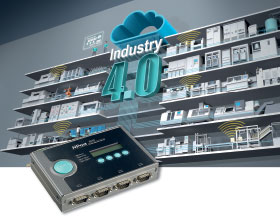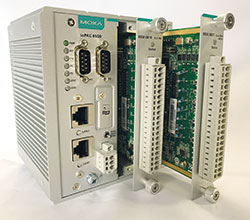

Since the advent of the IIoT/Industrie 4.0, a number of challenges have been stacking up at production lines. These include high or low-quantity production, an increased demand for customised products, zero error rates, and mixed-model production lines.
Consequently, these challenges have set in motion a number of changes in factories, culminating with the introduction of new technologies and concepts.
As optimal production is pivotal in the age of the IIoT, overall equipment effectiveness (OEE) has emerged as a key performance index (KPI) in the manufacturing industry. OEE benchmarks the percentage of manufacturing time that is truly productive. An OEE score of 100% shows that the producer is manufacturing only good parts, as fast as possible, with no downtime. OEE’s KPI formula incorporates three elements: availability – no downtime; performance – the speed of production; and quality – the percentage of products up to standard.
Availability
Collecting data for predictive maintenance, understanding machine status to reduce downtime, and overall network reliability
During production, machines generate different types of data, such as vibration, motor current and coolant levels. Based on this data, machine maintenance engineers schedule maintenance tasks (predictive maintenance) to avoid any unexpected machine downtime. However, the data presents itself in different forms. One is streaming data, which is transmitted in big volumes and requires pre-processing before it is sent to a back-end system. The other is status data, which is transmitted in small volumes and via a transparent method without any pre-processing. Thus, the system has to use different methods to collect both status and streaming data. For status data, the best way is to use transparent data collection. For streaming data, the best way is to use front-end data processing to downsize the data to provide valuable information to the back-end system. Downsizing is necessary because there will be too much streaming data to transfer all of it to a back-end system.
Building a reliable network infrastructure to maximise uptime
Most PLC networks rely on the Internet Group Management Protocol (IGMP) for multicast transmissions. For example, implicit communications, usually used to check the availability of systems that connect PLCs and devices, are based on multicast. Together with its Turbo Ring solution, Moxa offers its pioneering V-ON technology, which enables the physical network to recover unicast and multicast traffic within milliseconds whenever there is a failure. V-ON ensures that the system keeps running and maximises productivity.
Performance
Reducing the changeover time to increase machine productivity
Reliable on-chip flow-control data transmission increases productivity. High customisation capability is a significant value of the IIoT, prompting regular changes in the programming of computer numerical control (CNC) machines. However, because a CNC buffer is limited, and programs are relatively big, CNC machines usually require a long time to download new programs. Therefore, the stability of the data transfer is very important, especially in old machines with serial interfaces. A serial-to-Ethernet device server with a flow-control feature is normally used on incoming data to prevent data drop, eliminating the need to resend these dropped packets. Spending more time on data transfers means less manufacturing time.
With Moxa’s on-chip flow-control feature, device servers (NPort) are able to process the stoppage (Xoff) directly from a UART, which eliminates data loss when a program is changed.
An intelligent supervisor meets various demands for mixed-model production
Mixed-model production entails a high degree of variation that includes thousands of different options and combinations to produce customer-specified components and multiple product types on the same assembly line. To increase the productivity of machines and operators, Moxa’s ioPAC 8500 programmable controller helps categorise the production tasks, ensuring that the task sequence can be automatically retrieved from an MES (Manufacturing Execution System). For example, tools are identified by an RFID tag, and an ioPAC retrieves the production method from the system and notifies all the relevant machines via an industrial protocol, such as Modbus. The production information is then sent back to the MES via an IT protocol.

Quality
Achieving zero defects and providing early warnings
Measurements and calibrations are important for CNC-machine applications and production data is the key to understanding the situation. Two types of data are applicable: stable data (on/off and status, the volumes of data are small) and temporary data (generated over short periods, needs to be recorded without missing any parts).
The generation of temporary data indicates that production quality is being affected, therefore, it is important to collect this precisely. Moxa provides a ruggedly designed IIoT data gateway to help customers collect precise data in harsh environments so that the line manager is kept up to date with regard to the status of all devices in the field.
Moreover, the ioPAC uses an open platform, and customers can implement their program to do data pre-processing in order to retrieve valuable information for predictive maintenance from the raw data, thus reducing traffic between the IIoT gateways and back-end servers. The ioPAC also provides Azure cloud-ready connectivity, allowing users to push data to the Azure cloud and leverage third-party software to do data mining or data analysis.
Deploying an IIot/Industrie 4.0 cloud solution
Data collection is the first step to realising an IIoT application. More and more IIoT technologies are being adopted, such as cloud services or pub/sub protocols, to collect this data from the monitored systems. This move is essentially mandatory due to the fact that the amount of data involved is expanding at an ever-increasing rate. Moxa’s IIoT Solutions’ Smart I/O and MX-AOPC UA Suites are designed for deploying data to a private, public or hybrid cloud, which provides the most seamless and efficient way to reduce integration effort and lower the total cost of ownership. Developing IIoT cloud technologies users will need to be familiar with databases such as Microsoft’s Azure, Amazon’s AWS and more to come. Furthermore, new protocols have been developed to allow data to be pushed to these cloud services, namely RESTful API and MQTT. Moxa’s IIoT products supports these cloud services and allow easy integration using MX-OPC UA and ThingsPro.
For more information contact RJ Connect, +27 (0)11 781 0777, [email protected], www.rjconnect.co.za
| Tel: | +27 11 781 0777 |
| Email: | [email protected] |
| www: | www.rjconnect.co.za |
| Articles: | More information and articles about RJ Connect |

© Technews Publishing (Pty) Ltd | All Rights Reserved